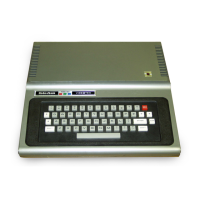CHR$
may also be used to display any
of
the graphics or special characters. (See
Appendix
C,
CharacterCodes.)
'+60
CLB
470
FOR
I =
129
TO
191
480
PRINT
I;
CHR$(I),
LI·90
NEXT
~)
00
GOT
0
~5
((j0
(RUN
the program to see the various graphics characters.)
Codes
0-31 are display control codes. Instead
of
returning an actual display
character, they return a control character. When the control character is
PRINTed,
the function is performed.
For
example, 23 is the code for 32 character-per-line
format; so the
command,
PRINT
CHR$(23)
converts the display format to 32
characters
per
line. (Hit
CLEAR,
execute
CLS,
or
execute
PRINT
CHR$(28)
to return to
64character-per-line format.)
FRE(string)
When used with a string variable
or
string constant as an argument, returns the
amount
of
string storage space currently available. Argument mustbe enclosed in
parentheses.
FRE
causes
BASIC
to start searching through memory for unused string
space.
If
yourprogram has done a lot
of
string processing, it may take several
minutes to recover all
the'
'scratch pad" type memory.
500 PRINT FRE(A$), FRE(L$), FRE ("Z")
All return the same value.
The string used has no significance; it is a dummy variable. See Chapter
4,
CLEARn.
FRE(number) returns the amount
of
available memory (same as MEM).
5/3
